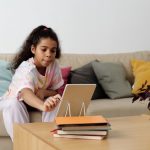Understanding the Importance of Digital Safety for Children
The internet has become an integral part of the lives of children today. From educational resources to socializing and entertainment platforms, children are exposed to a wide range of digital content. While the digital world offers countless opportunities, it also comes with inherent risks and dangers. That is why it is crucial for parents and guardians to understand the importance of digital safety for children.
Digital safety encompasses various aspects, including online privacy, protecting personal information, and safeguarding against cyberbullying and inappropriate content. By instilling good digital safety practices from a young age, parents can help ensure that their children have safe and positive online experiences. Moreover, teaching children about digital safety not only protects them from potential harm but also empowers them to become responsible digital citizens as they grow older. At a time when children are increasingly connected to the digital world, prioritizing their safety should be a top priority for every parent.
Identifying Potential Online Risks and Dangers
Online safety is a crucial concern for parents in today’s digital age. As children spend more time online, it becomes increasingly important to be aware of the potential risks and dangers they may encounter. One of the first steps in ensuring their safety is to identify these risks.
One common risk is cyberbullying. With the anonymity provided by the internet, children may become victims of hurtful comments, harassment, or even threats from their peers or strangers. It is essential for parents to recognize the signs of cyberbullying, such as changes in mood or behavior, and take appropriate action to protect their child’s well-being. Additionally, parents should educate their children about online etiquette and the importance of treating others with respect and kindness. By identifying the risk of cyberbullying, parents can take proactive measures to prevent and address this issue.
Exploring the Different Types of Parental Control Tools
Parental control tools have become a crucial aspect of ensuring the online safety of children. With the rapid development of technology, there are various types of tools available to help parents monitor and regulate their child’s online activities. One common type is content filtering, which allows parents to block access to inappropriate websites and materials. These tools often have customizable settings that can be adjusted depending on the age and maturity of the child. Additionally, many parental control tools offer time management features, enabling parents to set limits on the amount of time their child spends online. This can help prevent excessive screen time and promote a healthy balance between online and offline activities. Some parental control tools also provide monitoring capabilities, allowing parents to view their child’s internet browsing history and online interactions. This level of oversight can help identify potential risks or suspicious activities, providing an opportunity for timely intervention. Ultimately, exploring the different types of parental control tools is essential in finding the most suitable features to protect children from online risks and dangers.
Another type of parental control tool is application blocking, which allows parents to selectively disable certain apps or games on their child’s device. This can be particularly useful in preventing children from accessing age-inappropriate content or becoming too reliant on specific applications. Moreover, location tracking features are becoming increasingly popular among parental control tools. These tools allow parents to monitor their child’s whereabouts using GPS technology, providing an added layer of security and reassurance. Additionally, some parental control tools offer social media monitoring, giving parents insight into their child’s online interactions on platforms like Facebook, Instagram, or Snapchat. This can help parents ensure that their child is engaging in healthy and appropriate online relationships. As technology continues to advance, it is important for parents to explore the different types of parental control tools available to them, as each tool offers unique features that may better suit their individual needs and concerns.
Setting Up and Configuring Parental Restrictions on Devices
One of the key steps in ensuring your child’s digital safety is setting up and configuring parental restrictions on their devices. This helps you control and monitor their online activities, protecting them from potentially harmful content and interactions. The process varies depending on the device and operating system, but it typically involves accessing the device’s settings or preferences and enabling the appropriate restrictions or controls.
For smartphones and tablets, both Android and iOS offer built-in parental control features that allow you to set limits on app usage, restrict access to certain websites, and manage screen time. On Android devices, you can find these settings by going to the device’s settings menu and searching for “Parental controls” or “Digital wellbeing.” On iOS devices, you’ll find parental control options under the “Screen Time” settings.
For computers, both Windows and macOS provide parental control features that allow you to create user accounts for your child with specific restrictions. On Windows, you can access these settings by going to the “Family options” in the settings menu. On macOS, you can use the built-in “Parental Controls” feature under the “System Preferences” menu to set up restrictions for your child’s user account.
Monitoring and Managing Your Child’s Online Activities
It is essential for parents to actively monitor and manage their child’s online activities to ensure their safety and well-being in the digital world. By regularly checking their browsing history, social media accounts, and online interactions, parents can have a better understanding of what their child is exposed to online. This can help identify any potential risks or dangers, such as inappropriate content, cyberbullying, or online predators.
In addition to monitoring, it is crucial to establish rules and guidelines for internet usage. Parents should communicate with their child about appropriate online behavior and set boundaries on the types of websites they can visit and the amount of time they can spend online. Installing parental control software or using built-in features on devices can provide an added layer of protection, allowing parents to restrict access to certain websites, limit screen time, and monitor and block certain activities. By actively monitoring and managing their child’s online activities, parents can play an active role in safeguarding their child’s digital well-being.
Balancing Privacy and Security: Respecting Your Child’s Digital Independence
As parents, it is crucial to strike a balance between privacy and security when it comes to our children’s digital independence. While it is important to protect them from potential online risks and dangers, it is equally essential to respect their need for privacy and personal space. Constantly monitoring and controlling their every online move may have unintended consequences, such as eroding trust and hindering their personal growth.
Allowing your child some level of privacy is not only important for fostering trust but also for encouraging healthy digital habits. Giving them the freedom to explore the online world on their own helps them develop critical thinking skills, independence, and self-responsibility. Of course, this does not mean turning a blind eye to their online activities, but rather finding a middle ground where privacy and security coexist. By providing guidance, open communication, and education about responsible internet use, you can empower your child to make informed decisions while still ensuring their safety.
Addressing Common Concerns and Misconceptions About Parental Control Features
Parental control features are often met with concerns and misconceptions from parents. One common concern is that these features may invade a child’s privacy. However, it is important to understand that parental controls are designed to strike a balance between privacy and safety. By monitoring and managing your child’s online activities, you are ensuring their digital well-being without intruding excessively into their personal space. It is crucial to have open and honest conversations with your child about the reasons behind implementing these controls, emphasizing that they are in place to protect them from potential online risks.
Another misconception is that parental controls are only applicable to younger children. However, as children grow and navigate the complexities of the online world, the need for these controls remains. Even teenagers can benefit from the guidance and boundaries provided by parental control features. It is essential to remember that these tools are not about restricting a child’s freedom, but rather about instilling responsible internet use and fostering healthy digital habits. By addressing and debunking these common concerns and misconceptions, parents can fully leverage the benefits of parental control features for their child’s digital safety.
Best Practices for Communicating with Your Child about Digital Safety
One of the most important aspects of ensuring your child’s digital safety is open and effective communication. It is essential to establish a dialogue with your child about the potential risks and dangers they may encounter online. Start by having regular conversations with them about their online activities, interests, and the platforms they use. Encourage them to share their experiences, both positive and negative, so you can understand their online world better.
When discussing digital safety, it is important to maintain a positive and non-judgmental tone. Avoid lecturing or criticizing your child’s choices, as this can create a barrier to open communication. Instead, focus on building trust and understanding. Let your child know that you are here to support and guide them through their online journey. Encourage them to come to you if they ever feel uncomfortable or encounter something that concerns them. By fostering a safe and open dialogue, you can strengthen your child’s awareness and ability to make responsible choices online.
Nurturing Healthy Digital Habits and Responsible Internet Use
Creating and maintaining healthy digital habits is essential in today’s technology-driven world. As a parent, it is important to guide and educate your child on responsible Internet use to ensure their safety and well-being online. One way to nurture healthy digital habits is by setting clear boundaries and rules regarding their online activities. This can include limiting screen time, specifying appropriate websites and apps, and discussing the importance of online privacy and security.
Another crucial aspect of fostering responsible Internet use is open and ongoing communication with your child. Encourage them to ask questions and share their online experiences with you. This will not only strengthen your bond but also help you identify any potential risks or concerns they may encounter. By maintaining an open dialogue, you can guide them towards making informed choices, teaching them to critically evaluate content, and encouraging them to think before sharing personal information online. Additionally, it is important to model responsible digital behavior yourself, as children often learn by observing their parents. By practicing what you preach, you can inspire your child to follow suit and develop healthy digital habits that will benefit them throughout their lives.
Ongoing Evaluation and Adjustments: Ensuring the Effectiveness of Parental Restrictions.
Effectively implementing parental restrictions is just the first step in ensuring the digital safety of your child. Ongoing evaluation and adjustments are necessary to make sure that these restrictions remain effective as your child grows and their online activities evolve. Regularly reviewing the effectiveness of the restrictions you have in place allows you to stay up-to-date with the latest digital risks and make necessary changes to enhance your child’s safety.
One key aspect of ongoing evaluation is monitoring your child’s response to the restrictions. Pay attention to how they interact with their devices and the internet. Are they constantly finding ways to bypass the restrictions? Are they expressing frustration or are they consistently following the guidelines you have set? This information can provide insights into the effectiveness of your current restrictions and help you identify any gaps or areas that need improvement.
What is the importance of digital safety for children?
Digital safety is crucial for children as it helps protect them from potential online risks and dangers, such as cyberbullying, inappropriate content, and online predators.
What are some potential online risks and dangers that children may face?
Some potential online risks and dangers include cyberbullying, exposure to inappropriate content, online predators, identity theft, and online scams.
What are the different types of parental control tools available?
There are various parental control tools available, such as content filtering, time restrictions, website blocking, app monitoring, and social media tracking.
How can I set up and configure parental restrictions on devices?
The process may vary depending on the device, but generally, you can set up parental restrictions in the device settings or by using third-party parental control software. Refer to the device’s user manual or online resources for specific instructions.
How can I monitor and manage my child’s online activities?
You can monitor and manage your child’s online activities by using parental control apps, checking browsing history, setting up alerts or notifications, and having ongoing conversations with your child about their online activities.
How can I balance privacy and security while respecting my child’s digital independence?
It is important to find a balance by allowing your child some privacy while ensuring their safety. This can be achieved by setting age-appropriate boundaries, having open and honest conversations, and gradually granting more independence as your child grows.
What are some common concerns and misconceptions about parental control features?
Some common concerns and misconceptions include the idea that parental control tools are invasive, impede a child’s privacy, or hinder their development. However, when used appropriately, these tools can enhance digital safety and promote responsible internet use.
What are some best practices for communicating with my child about digital safety?
It is important to have open and ongoing conversations with your child about digital safety. Some best practices include listening to their concerns, setting clear expectations and boundaries, educating them about online risks, and fostering an environment of trust and support.
How can I nurture healthy digital habits and promote responsible internet use?
Encourage your child to develop healthy digital habits by setting screen time limits, promoting offline activities, teaching them about responsible online behavior, and being a positive role model in your own internet use.
How can I ensure the effectiveness of parental restrictions over time?
Regular evaluation and adjustments are necessary to ensure the effectiveness of parental restrictions. Stay informed about new online risks, regularly communicate with your child, update parental control settings as needed, and adapt to your child’s changing needs and maturity level.




